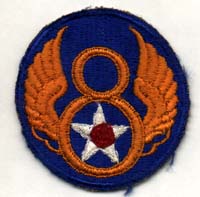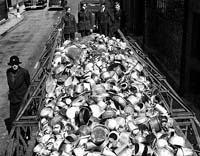 |
 |
 The colours of the Suffolk Regiment |
In this part of the history of the St Edmundsbury area of Suffolk we will enter realms which most Tourist Information Centres do not mention. History did not cease in our area with the Dissolution of the Monasteries or even with the First World War, and some of our visitors will come here because of the lives they experienced here in times of conflict.
Concrete pillboxes and decaying Nissen huts are not rated as tourist attractions yet, but that time will come in the near future. We can already see the control towers of some old airfields being refurbished for museum purposes.
Meanwhile you will experience this modern history most vividly in the tears of veterans on Remembrance Day or at their memorials, or most of all when they revisit the sites of bases and camps where they, or those close to them, spent some brief but traumatic years.
Most places in England will have some connections with the military, but the two dominant military features of the St Edmundsbury area are the legacy of the Suffolk Regiment, and our wartime airfields. |

|
Most of the wartime flying in our area was carried out by the 8th United States Army Air Force, (USAAF), with only a small cluster of nearby RAF stations, while the Suffolk Regiment had its depot at the Gibraltar Barracks in Out Risbygate, Bury St Edmunds. Blenheim Camp was also in the same road but further out of town. By 1945 there were a range of facilities for servicemen open in Bury St Edmunds. There were various cafés and teashops as well as the official or voluntary providers. In his book "Suffolk Summer" John Appleby described the following places. The Forces Study Centre was in Chequer Square, diagonally across from the Norman Tower, "in a pleasant house of rambling passages and old oak beams." It was operated by the British Army Educational Corps with at least one good concert a week, classes in French and German, carpentry, woodwork and toymaking, a play reading group and discussion groups. At weekends excursions were arranged and troops and townspeople alike used these facilities. The Salvation Army had a canteen in Abbeygate Street open all hours for tea and sandwiches. The YMCA hostel also served tea in the garden. The people of Bury ran their own Sunday afternoon Canteen in the Athenaeum on Angel Hill for the troops. Committees of volunteers provided teas, sandwiches and cakes, and a lending library and mending service occupied a corner each of the ballroom. According to Appleby the fare was the best in Bury and you could eat your fill for under a shilling. In today's money this is 5 pence, but must be related to wages of the day, when a workman might get £5 a week. American service pay was well over three times the English, and their rations were far more generous and diverse. Chocolate bars, sweets and chewing gum were liberally distributed to any civilians the Americans encountered. Stricter parents forbade their offspring to ask for sweets and often frowned on any contact at all. The Athenaeum Canteen closed in September 1945, but it is interesting to note that then, just as today, visitors wrestled with its pronunciation and "Athenium" was mainly used by the troops. Appleby records that these places welcomed troops of all nationalities, whereas the US Red Cross Clubs barred British servicemen unless guests of Americans. The American Red Cross Officer's Club in Bury was in Westgate Street, facing up Guildhall Street. British soldiers might use the Church Army Canteen in St Botolphs Lane, which is now a Suffolk Housing Association housing scheme, or the British Restaurant in Crown Street where there is now a yard for the Brewery. The Royal Corps of Signals had a signal office in a house on Southgate Green, now demolished by the roadworks in that area. Dispatch riders went from there all over East Anglia emphasising the fact that local telephone communications were rudimentary as well as insecure. The men were billeted in homes in Southgate Street and around. On the agricultural front some Land Army women were billeted in a house on Southgate Green. Prisoners of War were housed on Hardwick Heath in a makeshift camp, and after the war were put to work on local farms. Italians built the concrete roads for the newly planned Mildenhall Road Estate. The elegant Queen Ann house known as Angel Corner housed the Ministry of Food during the war, although it was responsible for rationing it out, rather than producing it. In 1946 it became the local Civil Defence HQ for Area 14 (most of West Suffolk) and in the 1960's its cellars were used as the Emergency Planning Centre. |

|
In the aftermath of war many of our buildings looked different as railing were removed to be melted down "for the war effort". Even pots and pans were collected for their aluminium to use for aeroplanes. Sadly, most of these efforts were wasted as the materials were not of good enough quality. Today, the Army no longer has a regular base in the town although the Territorial Army still maintains a presence at Blenheim Camp. The Suffolk Regiment was reorganised in 1959 to become part of the Royal Anglian Regiment. A small Suffolk Regiment Museum collection remains. The USAF has two remaining bases at Mildenhall and Lakenheath in the adjacent district of Forest Heath. The RAF Regiment is based at Honington replacing the flying units previously stationed there. The history of the airfields is often complex, as several were to pass between the RAF and the USAF at different times, but our aim is to let you see details of every base in our area if you want to, and to tell you about what happened there and why. Fuller information is available under the following headings:- The Suffolk Regiment and the Army - details of the major battles and postings, the Regimental Museum and history from 1685 The Royal Air Force - includes all the stations and their pre war, wartime and post war stories The United States Air Force - includes information on wartime bases, post war bases, wartime history and post war history. This information is also available through the American Connections section. |
| Go to Military Homepage | Updated 4th September 2004 | Go to Home Page |